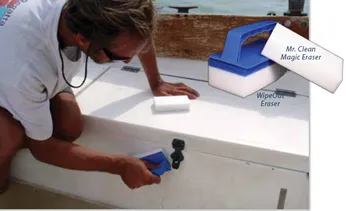
346
A few months ago, we noticed that our dock neighbors were cleaning their decks with spongy-looking pads called Mr. Clean Magic Erasers. Ditching multiple cleaners for one re-usable sponge was very alluring. About that same time, PS reader Bob Buck introduced us to the WipeOut Eraser, essentially a Magic Eraser on steroids. We decided a head-to-head test was in order.
The Magic Eraser and the WipeOut Eraser are nearly identical in function and composition. Made in Germany, both are rectangular nanofiber pads that resemble white sponges. But unlike sponges, they don’t require adding a cleaner and instead use a unique cleaning action to lift and trap dirt. Users simply saturate the pads with water and wipe away dirt and stains. As the pad cleans, the nanofibers break down, so the eraser must be rinsed often to wash away the dirt and the spent fibers. The fibers are nontoxic and odorless, and there are no cleaners in the pad, so users need not worry with wearing gloves.
Proctor & Gamble’s original Mr. Clean Magic Eraser measures 4.6 inches long, 2.4 inches wide, and 1 inch thick. The WipeOut Eraser, developed by Ralph Perez, is larger (5.5 x 2.75 x 1.7 inches) and features a scrub pad and an attachable plastic handle for jobs that call for a little more elbow grease.
How We Tested
We tested the WipeOut and Magic erasers aboard Skimmer, our Sarasota, Fla.-based Cape Dory 25 test boat that sees a lot of use and little TLC. The deck and cockpit had not been cleaned in several weeks, so we used the pads to clean the dirty gelcoat, molded-in nonskid, and the waterline, which had been sporting an ICW mustache for some time. We also tested the products’ abilities to tackle rust stains and scuffs.
Heeding Perez’s advice, we did not use the erasers on finished teak or the topsides. While the pads are quite soft, using them on a glossy hull , brand-new gelcoat, or varnished wood could scratch the surfaces. Similarly, we’d be hesitant to use them on waxed surfaces.
Testers also put the pads to work in our shoreside bathroom, pitting them against mildewed grout and soap scummy showers.
What We Found
Both the Magic Eraser and WipeOut Eraser lived up to their billing, easily wiping away dirt, mildew, scuffs, and some stains. The products handled everything testers threw at them with the exception of rust stains around stanchion bases on the Cape Dory.
The trick to using the pads is to continually rinse them in water to release the wiped-up grunge and spent nanofibers. Ideally, you rinse them in fresh water so there’s no risk of salt buildup or salt scratching a surface. We rinsed them in salt water only while we were scrubbing the waterline, which is where the WipeOut stood out.
With a large, heavily slimed, stained area to clean, the WipeOut’s scrubber pad and handle were necessary. The Magic Eraser was no match for the ICW mustache. The WipeOut didn’t get the waterline as sparkling clean as heavy-duty acids like Marykate’s On & Off (November 2007), but it got it pretty darn clean, without the need to haul the boat or use harsh chemicals.
Both pads had a tendency to tear if used aggressively, but the Mr. Clean pad fell apart more readily. The WipeOut’s blue scrubber seemed to help hold the pad together better. According to Perez, the nanofibers do not stretch; they tear. He said the pads should not be thought of like a cleaning sponge, but more like a napkin. If you’re a heavy-handed scrubber, use caution when cleaning with nanofiber pads.
The Bottom Line
These things really work, and they are ideal for quick cleanups or waterline scrubbing between haulouts. The pads will wear away faster than a regular sponge, but they are cheap—$3 for two Magic Erasers or $9 for two WipeOut pads—so restocking won’t break the bank, especially compared to the pricey specialty cleaners they could replace.
The WipeOut’s scrubber and handle make it better suited for onboard cleaning, and its larger size means it will last longer than the petite Magic Eraser original. The Magic Eraser is effective but not as durable or as versatile as the WipeOut Eraser. We’d leave Mr. Clean ashore, but the WipeOut Eraser is worth adding to your boat’s maintenance arsenal.

































